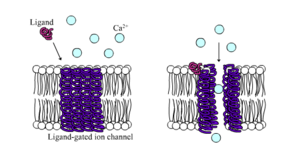Ligand-gated ion channel
Editor-In-Chief: C. Michael Gibson, M.S., M.D. [1]

The Ligand-gated ion channels, also referred to as LGICs, or ionotropic receptors, are a group of intrinsic transmembrane ion channels that are opened or closed in response to binding of a chemical messenger, as opposed to voltage-gated ion channels or stretch-activated ion channels.
Regulation
The ion channel is regulated by a ligand and is usually very selective to one or more ions like Na+, K+, Ca2+, or Cl-. Such receptors located at synapses convert the chemical signal of presynaptically released neurotransmitter directly and very quickly into a postsynaptic electrical signal.
Many LGICs are additionally modulated by allosteric ligands, by channel blockers, ions, or the membrane potential.
Example: nicotinic acetylcholine receptor
The prototypic ligand-gated ion channel is the nicotinic acetylcholine receptor. It consists of a pentamer of protein subunits, with two binding sites for acetylcholine, which, when bound, alter the receptor's configuration and cause an internal pore to open. This pore, permeable to Na+, allows Na+ ions to flow down their electrochemical gradient into the cell. With a sufficient number of channels opening at once, the intracellular Na+ concentration rises to the point at which the positive charge within the cell is enough to depolarize the membrane, and an action potential is initiated.
Classification and examples
Many important ion channels are ligand-gated, and they show a great degree of homology at the genetic level. The Ligand-gated ion channels are classified into three superfamilies:
The Cys-loop receptors
- anionic
- cationic
The ionotropic glutamate receptors
The ATP-gated channels
Clinical relevance
Ligand-gated ion channels are likely to be the major site at which anaesthetic agents have their effects, although unequivocal evidence of this is yet to be established. In particular, the GABA and NMDA receptors are affected by anaesthetic agents at concentrations similar to those used in clinical anaesthesia.
See also
References
- Connolly, CN (2004). "The Cys-loop superfamily of ligand-gated ion channels: the impact of receptor structure on function". Biochem. Soc. Trans. 32 (3): 529–534. ISSN 0300-5127. PMID 15157178. Retrieved 2007-06-08. Unknown parameter
|coauthors=ignored (help)
External links
- Ligand-Gated Ion Channel database at European Bioinformatics Institute. Verified availability April 11, 2007.